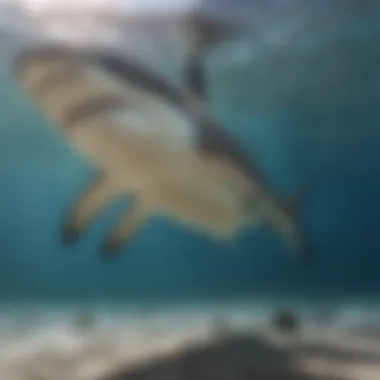Exploring the Fascinating World of Sharks


Intro
The world of sharks presents an intricate tapestry of biology, behavior, and ecological significance. As apex predators, sharks play crucial roles in maintaining marine ecosystems. This examination seeks to unravel various aspects of these remarkable creatures, guiding both enthusiasts and laypersons through their unque attributes. From unique biological characteristics to the pressing conservation challenges they face, understanding sharks enhances our appreciation for them.
Animal Species Profile
Intro to the animal species
Sharks, a diverse group of cartilaginous fish, have existed for approximately 420 million years. They occupy a range of habitats from shallow coastal waters to the deep sea. With over 500 species, each exhibits different adaptations suited for their environmental niches. This includes the massive whale shark, known for its gentleness, and the formidable great white shark, a symbol of strength.
Physical characteristics and appearance
Physically, sharks are characterized by their streamlined bodies, multiple rows of teeth, and exceptional sensory systems. Their exterior generally features a range of colors, including shades of blue, grey, and white, often aiding in camouflage from predators and prey. Many species are recognizable by unique markings or features, such as the hammerhead’s distinctive head structure, which enhances their sensory perception.
Natural habitat and distribution
Sharks inhabit various marine environments. Most live in warm, shallow coastal waters, while others thrive in deeper oceanic regions. The distribution of species varies; for instance, while the oceanic white-tip shark roams vast areas of the open ocean, the bull shark can endure both salt and freshwater, allowing it to venture into rivers and estuaries.
Behavior and social interactions
Most sharks are solitary hunters, but some species, such as the hammerhead and the bull shark, showcase social behavior. They often swim in schools, especially during mating seasons. Their hunting behaviors are a blend of stealth and speed, relying on exceptional eyesight and electroreception to detect prey. This behavioral nuance reflects their evolutionary successes.
Conservation & Wildlife Efforts
Overview of conservation status
Shark populations face severe threats due to overfishing, habitat loss, and climate change. According to the International Union for Conservation of Nature(IUCN), a significant number of species are classified as vulnerable or endangered. Understanding their conservation status is vital for shaping effective management and policy frameworks.
Threats to the species
The principal dangers sharks confront include:
- Overfishing: Driven by demand for fins and meat.
- Bycatch: Many sharks are unintentionally caught in fishing gear targeting other species.
- Habitat degradation: Coastal development and pollution disrupt vital shark habitats.
Conservation initiatives and organizations
Numerous organizations work towards shark conservation. The Shark Trust, Oceana, and WWF are leading efforts in policy advocacy, public education, and habitat protection. These organizations assist in vital research for understanding population dynamics and the long-term sustainability of shark communities.
Success stories and impact
Successful conservation stories include the recovery of particular species due to regional protections, such as the spawning habitats within marine reserves. Data-driven management policies can result in healthier marine ecosystems and encourage responsible fisheries practices, showcasing that concerted efforts yield results.
The preservation of sharks is intricately tied to the health of marine ecosystems, affecting fisheries and even coastal economies.
Animal Behavior & Psychology
Communication and language cues
Sharks communicate primarily through body language and subtle behavioral cues. Porpoising, where sharks leap from the water, may communicate excitement or aggression.
Reproductive behavior and parenting
Shark reproduction varies significantly across species. Some give birth to live young while others lay eggs. The egg cases can often be found stuck to rocks or vegetation in seagrass habitats, protecting them until hatching.
Cognitive abilities and problem-solving skills
Research indicates that sharks exhibit impressive learning capabilities. They can adapt their hunting strategies based on environmental changes and have been shown to navigate complex environments effectively.
Emotional intelligence and social dynamics
Emerging studies suggest sharks possess a level of social intelligence. Interactions among individuals can reveal bonding behaviors that imply a framework beyond mere survival instincts.
Unique Facts & Trivia
Little-known facts about the animal
- Sharks have been around longer than trees.
- Some varieties can detect low-frequency vibrations in the water from miles away.
Surprising behaviors or adaptations
The cookiecutter shark, small yet formidable, is known for taking precise bites, causing peculiar circular wounds on larger creatures, showcasing its unique feeding strategy.
Fun trivia and quirky behaviors
Certain species, like the great white shark, breach the surface while hunting seals, a stunning aerial display recognized as a hunting strategy.
Record-breaking feats or abilities
The whale shark, being the largest fish in the ocean, can reach lengths of over 40 feet, illustrating that sharks are more than formidable carnivores; they demonstrate ecological diversity.
Pet Care & Tips


While many may consider sharks for home aquariums, proper research is needed.
Choosing the right pet for your lifestyle
Leopard sharks or bamboo sharks are popular choices, known for compatible temperaments in larger aquariums. Proper habitat size is crucial.
Basic care requirements and habitat setup
A well-maintained saltwater setup is necessary, including proper filtration, temperature control, and space for swimming. Research individual species for specific needs.
Health and wellness tips for pet longevity
Regular water testing for salinity, pH levels, and tank cleanliness plays a critical role in ensuring shark health. Jiang a vet specializing in aquatic species is advisable.
Training techniques and behavioral enrichment ideas
Sharks can be stimulated through environmental enrichment objects in their habitat, mimicking natural exploration and encouraging more active behaviors.
Prolusion to Sharks
Sharks have fascinated humanity for centuries, serving as a whimsical symbol of both fear and reverence. In the realm of marine biology, they represent a category of apex predators, exemplifying survival and adaptation. The section on Introduction to Sharks aims to set the stage for a broader exploration of these enigmatic creatures, identifying critical themes that will be discussed throughout this article.
Understanding what sharks are, their biological distinctions, and their ecological role is paramount in cultivating a deeper awareness of our oceanic ecosystems. The intricate layers of shark diversity will leave one in awe, comparing the vastly different species. It provides context for future aspects addressed later on—be it behavior, physiology, or conservation efforts. Thus, recognizing the integral part sharks play can encourage informed discussion and actions related to their conservation.
What is a Shark?
A shark is a member of the subclass Elasmobranchii and part of the class Chondrichthyes. This means they have a skeleton made of cartilage rather than bone, setting them apart from most other fish. Sharks are a diverse group of marine species found in various habitats around the world. They possess unique attributes, including multiple rows of sharp teeth designed for specific feeding strategies. The combination of adaptability and specialized physical traits makes them masters of their underwater environment.
Compared to other fish, sharks have keen senses. Their ability to detect electrical signals through specialized organs called ampullae of Lorenzini distinguishes them in the chaotic underwater world. Sharks are mostly characterized as predators, but varying species have specific ecological functions—from scavengers to apex hunters. Feeling compelled to explore sharks transcends superficial attempts at fear; it embodies recognition of the sophisticated evolutionary adaptations they exhibit.
Shark Diversity and Classification
Sharks are incredibly diverse, with over 500 recognized species inhabiting the world’s oceans. They range in size from the tiny dwarf lanternshark, which measures just over eight inches, to the massive whale shark, stretching upwards of 40 feet. This section examines a classificatory schema comprised of several groups, including:
- Lamniformes: Includes notable species such as the great white and thresher sharks.
- Carcharhiniformes: Known as ground sharks, containing species like the tiger shark and bull shark.
- Orectolobiformes: Home to carpet sharks, such as the iconic whale shark.
Each group displays distinctive features and behaviors, determining their roles within marine ecosystems. Classification made easier through scientific criteria reinforces the need for a broad understanding of global shark populations. By differentiating among various species, it highlights biodiversity essential for maintaining balanced ocean health, thus laying the groundwork for later discussions regarding their ecological role in sustaining marine life.
“Awareness of shark diversity reveals not only lush ecological interdependence but also underscores the necessity for their protection in our complex marine ecosystems.”
The Biology of Sharks
The study of the biology of sharks is crucial for understanding their role in marine environments. This encompasses a range of topics, including anatomy, physiology, and behavioral adaptations vital for survival. The deeper insight into shark biology reveals how these creatures have evolved over millions of years. Furthermore, it highlights key elements that allow for effective conservation efforts. Understanding things like sensory organs, feeding mechanisms, and reproductive strategies enriches our knowledge about why sharks thrive in diverse habitats.
Anatomy of Sharks
The anatomy of sharks features unique structural traits that set them apart from other marine animals. Sharks possess a streamlined body, which aids in swimming efficiently. Their skeleton is made from cartilage, making it lighter than bone. This flexible design allows for greater maneuverability.
Key components include:
- Fins: Sharks utilize various fins such as dorsal fins, pectoral fins, and a caudal fin, each serving distinct purposes for stability and propulsion.
- Jaws: These creatures have powerful jaws with multiple rows of sharp teeth, essential for grasping prey. Notable species like the Great White cause great fear often due to their remarkable biting force.
- Gills: Sharks typically have five to seven gill slits on each side, which allow for respiration. As they move, water flows over these gills facilitating oxygen extraction.
This anatomical arrangement contributes to their hunting skills and various life strategies.
Physiology and Adaptations
Shark physiology is the study of their body functions and adaptations to underwater life. For instance, sharks are ectothermic animals, which means they rely on environmental temperatures to regulate their body heat. Some species, like the Great White or Mako shark, can maintain a higher body temperature, giving them an advantage in colder waters.
Shark adaptations to their environment involve several factors:
- Electroreception: Sharks have specialized organs, called ampullae of Lorenzini, allowing them to detect electrical signals produced by potential prey. This sensory ability is crucial for hunting in dark or murky waters.
- Lateral Line System: This system enables sharks to sense water vibrations and movements, enhancing their ability to react swiftly in pursuit of prey.
- Camouflage: Many species utilize coloration or patterns that help them blend into their surroundings, providing an advantage during attempts to ambush prey.
Understanding these physiological traits allows researchers to grasp how sharks adapt to their various habitats and helps determine necessary conservation strategies.
Sharks' biology not only illustrates their complexity but also emphasizes from an ecological perspective the critical functions they fulfill in marine systems.
Behavioral Patterns
Understanding the behavioral patterns of sharks is crucial for recognizing their ecological significance and vulnerabilities. By examining these patterns, we gain insights into their feeding, reproduction, and social interactions. Such information not only informs scientific understanding but also shapes conservation strategies. Each behavioral aspect presents unique adaptations that make sharks remarkable.
Feeding Behavior
Shark feeding behavior varies widely depending on the species and environment. Sharks are opportunistic feeders, meaning they will consume all types of prey available. Some species, like the Great White Shark, are known hunters and will stalk and ambush their prey using keen sight and smell. They often swim beneath seals before launching a powerful attack.
In contrast, filter-feeding sharks, such as the whale shark, consume plankton and small fish by straining them from the water. They swim with their mouths open, allowing water to flow through their gills while trapping food particles. This demonstrates how different feeding strategies foster diverse ecological niches within marine environments. Each species has adapted to position themselves at different parts of the marine food web, influencing population dynamics.
Key Aspects of Feeding Behavior
- Hunting Techniques: Methodology varies greatly; from active hunting to passive feeding.
- Prey Selection: Sharks can exhibit preferences depending on species and environmental availability.
- Impact on Ecosystem: Their feeding habits regulate the populations of other fish species, thus maintaining balance.
Reproductive Behavior
Sharks exhibit unique reproductive behaviors with a few fascinating variations across the species. Most sharks are ovoviviparous, meaning they develop their eggs inside their bodies, birthing live young. Such a strategy ensures higher survival rates in challenging marine environments. Some, like the nurse shark, are known to lay eggs in protective capsules called mermaid's purses.


Courtship in sharks often involves complex rituals, including body posturing and nudging. These displays can vary from gentle movements to aggressive shows of strength. It is essential to recognize that reproductive health and behavior directly influence shark populations and their ability to recover from overfishing.
Important Reproductive Aspects
- Mating Seasons: Most species have specific seasons that optimize their reproductive success.
- Parental Care: Generally low parental investment; sharks release the young and provide little to no support afterward.
- Life Cycle Influence: Lengths of gestation and number of offspring can greatly affect population dynamics, impacting conservation practices.
Social Structures
While sharks are often portrayed as solitary predators, many species have noticeable social structures. Some sharks, like the hammerhead, school together, providing safety in numbers. These gatherings can aid in finding mates, protecting themselves from larger predators, and cooperating in hunting practices.
Social behavior can hinge on environmental factors, such as water temperature and food availability. Time spent schooling also varies by species. The understanding of social behaviors provides valuable insight into sharks' ecological roles and how these behaviors adjust to changing environments. This knowledge can direct effective conservation efforts by addressing the conditions that influence their socialization.
Characteristics of Shark Social Structures
- Schooling Behavior: Allows for enhanced protection and coordinated hunting.
- Mating Sites: Certain sharks seek specific locations for breeding, influencing reproductive success.
- Territorial Behavior: Some species exhibit territoriality, maintaining dominance over hunting grounds.
Understanding these behavioral patterns shines a light on how sharks function within marine ecosystems, emphasizing their status as apex predators and their vital roles. Addressing threats to their populations will require ongoing study of their behavior and habitat responses.
Ecological Role of Sharks
Understanding the ecological role of sharks is crucial for grasping their significance in marine environments. Sharks contribute greatly to the balance of ocean ecosystems. They help maintain healthy populations of other species, which in turn supports the overall health of the ecosystem. This section discusses two main aspects: their position as apex predators and their overarching impact on marine ecosystems.
Sharks as Apex Predators
Sharks occupy the top of the food chain within marine environments. As apex predators, they play a vital role in controlling prey populations. By predating on weaker and ill individuals, sharks contribute to the health of their prey's population. This, in turn, facilitates a balance among species and helps avoid overpopulation and depletion of specific resources.
In ecosystems where sharks are plentiful, there is often a greater diversity of species. For instance, the presence of large sharks like the Great White or Tiger Shark signifies a robust health of other marine species. Removing sharks from these environments leads to what's known as a trophic cascade, where the dynamics of species interaction become destabilized, causing unpredictable and often harmful changes in the ecosystem.
Impact on Marine Ecosystems
Sharks have significant effects on marine ecosystems, influencing both the community structure and the health of the environment. Their feeding habits impact the distribution and behavior of other marine species. This changes the overall biodiversity in ocean habitats. As they navigate through their habitats, sharks help maintain the balance of marine life.
Conservation Challenges
Shark conservation is a topic that deserves attention for its potential effects on marine ecosystems and biodiversity. Conservation challenges represent significant barriers, including threats from overfishing and habitat loss. Addressing these challenges is critical for sustaining shark populations and their environments. Only by understanding these issues can we work towards effective solutions to protect these essential marine predators.
Threats Facing Sharks
Sharks face numerous threats in the modern world. Many of them are driven by human activities that interfere with their natural habitats and put their lives at risk. Here are some notable threats:
- Overfishing: Many shark species are targeted for their fins, meat, and other products. This creates a significant decline in their populations.
- Bycatch: Sharks are often unintentionally caught in fishing gear aimed at other species, which can lead to injury or death.
- Habitat Destruction: Coastal development, pollution, and ocean acidification are destroying crucial habitats like coral reefs and nursery grounds.
- Climate Change: Rising water temperatures and shifting ocean chemistry affect prey availability and breeding behaviors.
- Pollution: Chemicals and waste products enter the oceans, harming the health of the sharks and their ecosystems.
To combat these threats, specific measures must be established to yield positive outcomes in shark conservation.
The Importance of Shark Conservation
Shark conservation goes beyond protecting a single species. Sharks play an important role in maintaining the health of marine ecosystems. Their predatory behavior ensures that species populations are kept in balance, which helps prevent overpopulation of certain species that can lead to ecosystem collapse. Overall, protecting sharks is critical because a thriving marine environment is vital for all life forms.
The necessity for shark conservation is underscored by the following points:
- Biodiversity: Healthy shark populations contribute to the overall health of marine biodiversity.
- Ecosystem Balance: Sharks control fish populations, preventing overeating of essential flora and fauna.
- Economic Value: Healthy shark populations support tourism and recreational fishing, benefitting local economies.
- Research and Education: Conserving sharks promotes scientific research and public awareness about marine life.
"Sharks are integral to the oceanic ecosystem's balance, and their decline has far-reaching effects."
Long-term solutions include a combination of education, legal protections, and sustainable fishing practices to ensure future generations can appreciate these remarkable creatures.
The Role of Photography in Shark Conservation
Photography plays a significant role in the conservation of sharks. The visual impact of well-composed images can promote awareness and understanding of these extraordinary animals. Visually appealing photos draw attention to their beauty and complexity, challenging the often negative stereotypes surrounding sharks. When people connect with images emotionally, they become more inclined to support conservation efforts.
In the current climate of environmental degradation, understanding the efficacy of photography can aid in rallying public support for protective measures. Not only does it immortalize individual species, but it also captures their habitats and interactions. Through stark and vivid representation, the onus of conservation is placed into a collective responsibility.
Types of Shark Photography
There are various forms of shark photography that serve different purposes within conservation efforts.
- Documentary Photography: This showcases the various habitats of sharks and reveals their behavior in the wild. These images aim to document realities of shark life. They facilitate greater understanding and serve educational functions.
- Artistic Photography: This type emphasizes aesthetic elements. By focusing on the exquisite details of sharks' shapes, colors, and movements, artistic photography can capture viewers’ imaginations.
- Underwater Photography: Frequently emerging through diving adventures, underwater photography encapsulates the relationship between sharks and their ecosystems. It demonstrates how sharks occupy critical roles in marine biology.
- Portrait Photography: This concentrates specifically on individual sharks. Portraits aim to humanize these creatures, portraying them as being more than mere predators. Close-up portraits can convey unique traits and behaviors, fostering a sense of connection.
Investing in these types of photography is crucial, as they serve to educate, inform, and inspire change in behavior regarding sharks and marine conservation overall.
Effect of Images on Public Perception
Images have a causal relation to how one perceives sharks. The misconceptions about them largely arise from prevailing stereotypes shaped by fear and misunderstanding. As a result, images that accurately represent sharks contribute to more informed public understanding.
So much of the imagery surrounding sharks is shaped by media portrayals. Documentaries, films, and photographic exhibitions have shown powerful impacts on perceptions and behavioral shifts in audiences. Pictures portray actual truths, often simple but profound.
Famous Shark Species
Famous Shark species serve as key examples to understand the complexity and importance of sharks in a balanced marine ecosystem. Discussing specific species like the Great White Shark, Hammerhead Shark, and Tiger Shark reveals their distinctive attributes. It helps to understand their role in marine habitats and informs conservation strategies.
Great White Shark


Characteristics
The Great White Shark is large, powerful, and recognized for it’s smooth, torpedo-shaped body. One of its most remarkable traits is the presence of serrated teeth. These teeth give the shark an edge when hunting. Knowing the Great White’s size and speed is crucial, as it can reach over twenty feet in length and swim at speeds of over thirty miles per hour on short bursts. This combination of characteristics makes the Great White a subject of fascination and concern.
Behavior
Behaviorally, the Great White exhibits interesting adaptations. Primarily, it uses ambush techniques while hunting. This behavior enhances its effective predation strategy. Another notable characteristic is the way it breaches the surface while hunting seals, showcasing its power. This particular behavior illustrates not just its hunting prowess but also interactions within its ecological niche. Understanding this can undermine negative public perceptions.
Habitat
The habitat of the Great White Shark mainly includes coastal waters. This species prefers regions where the water temperature suits its physiological needs. Typical environments include the waters off California coast and around South Africa. Its habitat selection shows how its distribution connects with prey availability. Thus, habitat loss can directly impact this species significantly.
Hammerhead Shark
Characteristics
Hammerhead Sharks are distinguishable by their unique head shape. This broad, cephalofoil structure contributes to their excellent sensory perception. They have been known to visually sense electricity in the water. These characteristics elevate their status in the predator hierarchy. The Hammerhead’s unique features make this species particularly vital to marine health.
Behavior
In terms of behavior, Hammerheads are known for forming schools. These aggregations can consist of dozens or even hundreds of individuals. They exhibit social behaviors that differ from solitary sharks and demonstrate complexity in their interactions. Studying these behaviors offers insights into social dynamics within shark species, showcasing their versatility.
Habitat
Hammerhead Sharks thrive in tropical and temperate waters. They can be often found in shallower areas, like reefs, which provide both protection and hunting opportunities. Their choice of habitat supports their hunting strategies that require common prey, such as fish and cephalopods. Every alteration in their habitat could represent a significant threat.
Tiger Shark
Characteristics
Tiger Sharks are identifiable due to the stripes along their back. This characteristics provides a level of camouflage that helps them in predation. With a diverse diet, they are often dubbed as opportunistic feeders displaying flexibility in predation habits. This adaptive characteristic shows how adaptable they are in varied marine environments, enriching their role within marine ecosystems.
Behavior
Behaviorally, Tiger Sharks are known for their boldness. This can lead them to venture into areas where other sharks do not typically go. They exhibit solitary hunting techniques and feeding patterns. Understanding their bold behavior provides examples of adaptability against evolving marine threats.
Habitat
Tiger Sharks are versatile in habitat preference, they can migrate over long distances. Their range often includes shallow coastal waters but can also extend to deep seas. As predators, they occupy an essential place in their habitat, controlling prey populations and thus maintaining ecological balance.
Sharks in Culture and Media
Understanding the role of sharks in culture and media provides a unique lens through which to examine and influence overall public perception. This section sheds light on how these representations affect attitudes toward sharks and marine conservation. Through powerful media portrayals and literature, sharks have become more than creatures of the sea; they symbolize a complex interplay between fear, fascination, and ecological importance.
Representation in Film and Literature
Sharks have long had a presence in films and literature, profoundly shaping their image. From the chilling terror of
Future of Shark Conservation
Shark conservation is vital for maintaining the balance in marine ecosystems. Sharks play a critical role as apex predators, controlling the populations of various species beneath them in the food chain. Their preservation ensures not only their survival but also the health of numerous other marine life forms. In a world increasingly influenced by climate change, overfishing, and habitat destruction, understanding and implementing effective shark conservation strategies has never been more urgent.
Innovative Conservation Strategies
Innovative approaches are already shaping future attempts to conserve shark populations. Technological advancements have provided novel tools and methods for monitoring shark behavior and populations. Drones and underwater cameras are often used to track movements. The use of tagging initiatives can yield long-term data on migration patterns. As conservationists gain new insights, they can effectively target areas in need of protection.
In addition to technology, community-based initiatives are gaining traction. Engaging local fisheries in sustainable practices is essential for reducing bycatch. Creating marine protected areas can also help provide safe havens for various shark species. These designated areas allow populations to thrive without the pressure of fishing.
Collaboration between governments, NGOs, and communities creates a ripple-effect of awareness. An informed community is often more invested in local ecosystems and more motivated to protect them. Places like the Yellowstone to Yukon Conservation Initiative exemplify how connecting habitats can boost the marine and terrestrial ecosystems.
Community Involvement and Education
Community involvement serves as a cornerstone in the broader context of shark conservation. Many successful conservation efforts rely on educational programs that engage students and local populations. Through workshops, individuals quickly understand the significance of sharks and related marine ecosystems. Programs often dive into topics on sustainability and the effects of pollution, shedding light on sharks’ crucial roles.
Organizing citizen science projects broadens public awareness. For instance, initiatives that invite locals to report any shark sightings or interactions draw public interest in marine life. Not only does this foster community pride, but it also contributes to scientific data collection.
Another aspect is the role of social media in education. Platforms such as Facebook and Reddit facilitate discussions that may connect enthusiasts with conservation efforts. Online platforms also give voice to those advocating for sharks' protection.
Engaging in local educational events can summon greater acts of stewardship, inspiring future generations to invest in sustainable practices.
In summary, the future of shark conservation lies at the crossroads of innovation, community involvement, and education. By harnessing technology and fostering local engagement, we create a layered strategy aiming to protect these invaluable marine warriors.
Culmination
The examination of sharks is essential for understanding not only these magnificent creatures but their role in marine ecosystems and conservation efforts. As we have explored throughout the sections, various factors contribute to the need for protection and appreciation of sharks. Their unique biology and adaptations allow them to thrive in complex environments, emphasizing their importance in maintaining ocean health. As apex predators, they help regulate fish populations, which in turn supports biodiversity.
Addressing the issues surrounding shark conservation remains critical. The impact of overfishing, pollution, and climate change presents significant threats to their survival. Heightened awareness is the first step towards generating action. To confront misconceptions about sharks—largely propagated by media representations— education plays an essential role for the public, helping dismantle fears and encouraging responsible advocacy.
Ultimately, recognizing great white, hammerhead, and tiger sharks not just for their fearsome reputations but as pivotal organisms in marine ecosystems can foster appreciation rather than fear. The commitment to deeper understanding leads naturally to greater protection.
Summary of Key Points
- Sharks play a vital role as apex predators in maintaining balance within marine ecosystems.
- Conservation is urgently needed due to threats like overfishing and climate change.
- Public misconceptions often skew perceptions of sharks, best tackled through robust education efforts.
- Notable species like the great white, hammerhead, and tiger sharks showcase the diverse, intricate biology of these animals.
Call to Action for Readers
Efforts towards shark conservation can start with you. Learn about local initiatives that promote sustainable practices and decrease plastic waste. Educate your peers about the crucial role sharks play in ocean health.
Support organizations focused on shark research and protection, such as Oceana and the Shark Trust. Participate in local beach clean-ups or awareness campaigns that foster dialogue about marine life conservation. Ultimately, every small action can lead to significant change. When individuals advocate for sharks, we help in building a collaborative understanding that translates into lasting protection for these fascinating creatures.







